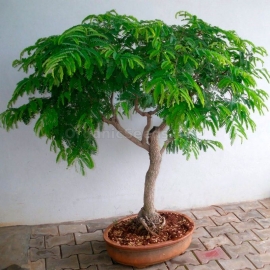 SALE
EXCLUSIVE
SALE
EXCLUSIVE






Tamarind indian Organic Seeds (Tamarindus indica)
1.50 €
2.00 € (Discount: 25%)
This tropical tree, at home, forms a crown with a height of 1.5 - 2 m, it has light green oval-shaped feathery leaves, which eventually acquire a rich dark green color.
-
Indian Tamarind or Indian Date fruit / Tamarindus indica
It is a tropical tree native to eastern Africa, including the dry deciduous forests of Madagascar.
Under favorable conditions, tamarind grows up to 20-30 m. At home, it forms a crown 1.5-2 m high. It has light green oval-shaped feathery leaves, which eventually acquire a rich dark green color. In the evening they add up. Tamarind flowers have five pink or yellow petals with red stripes. The petals are collected in racemose inflorescences. The fruits look like long beans with brown pods that do not expand.
Hidden under the peel is a reddish-brown pulp (pulp), which is used in the preparation of sour and spicy dishes, snacks and sauces. The ripe, sweet-tasting pulp is good for desserts and healthy drinks. Several smooth, hard, irregularly shaped seeds are hidden in the pulp.
Lighting: An adult tamarind needs bright light, so the pot with a tree should be placed on a window facing south, southeast or southwest. For uniform crown development, it is recommended to rotate the plant by a third of a turn. Lack of light leads to the cessation of leaf growth and tree diseases. But in the heat, especially in the midday heat, it should not be left.
Temperature: The temperature in the room should not drop below +15 degrees. Intense heat is not necessary, moderate temperature is most favorable. Tamarind is afraid of drafts. Loves spraying. During the ripening of the fruit, you should stop spraying.
Watering: The plant needs soft, settled water at room temperature. Avoid the accumulation of water in the sump (this requires soil drainage). Moderate watering is optimal for the tree. In winter, waterlogging can cause root rot.
Fertilization: It is recommended to fertilize tamarind in spring and summer every three months with any liquid top dressing for indoor plants or organic matter. In the spring, if necessary, a transplant is possible.
Tamarind needs sanitary pruning: the crown is formed until the 3-5 largest branches are formed.
